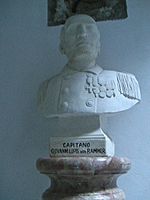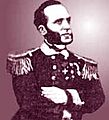Giovanni Luppis facts for kids
Quick facts for kids
Baron
Giovani (Ivan) Luppis
Frigate captain
|
|
|---|---|
 |
|
| Birth name | Giovanni Biagio Luppis von Rammer |
| Born | 27 August 1813 Fiume, Illyrian Provinces (now Rijeka, Croatia) |
| Died | 11 January 1875 (aged 61) Milan, Kingdom of Italy (now Italy) |
| Allegiance | |
| Service/ |
|
| Battles/wars | Second Italian War of Independence |
Giovanni (Ivan) Biagio Luppis Freiherr von Rammer (born August 27, 1813 – died January 11, 1875) was an officer in the Austro-Hungarian Navy. He is famous for leading the team that created the very first self-propelled torpedo. Sometimes, he was also known by his Croatian name, Vukić.
Contents
Giovanni Luppis: His Early Life
Giovanni Luppis was born in 1813 in a city called Rijeka. At that time, Rijeka was part of the Illyrian Provinces, but it soon became part of Austria. His parents were Ferdinando Carlo and Giovanna Parich. His family was important in the city, known for owning many ships.
Because his family had both Italian and Croatian roots, they were sometimes called Vukić. This name is a Croatian version of "Luppis," and both names mean "wolf." This is why Giovanni himself is sometimes called Ivan Vukić, especially by Croatians.
Giovanni went to a high school in Fiume. Then, he studied at the Collegio di marina, which was the Austrian naval academy in Venice. Later, he married a noblewoman named Baroness Elisa de Zotti.
He joined the Austrian Navy and worked his way up. He became a Frigate Captain. In 1848 and 1849, he served as an officer on ships that blocked the city of Venice.
The "Coastsaver" Idea
Around the mid-1800s, an officer in the Austrian Navy had an idea. He thought of using a small boat filled with explosives to attack enemy ships. This boat would be powered by steam or air and guided by a cable. When this officer died, his notes about this invention ended up with Captain Giovanni Luppis.
Luppis imagined a floating device that could destroy ships. It would have no crew and be controlled from the land. The explosives would blow up when the device hit an enemy ship. His first try was a one-meter-long model. It had glass wings and was controlled by long ropes from the shore. But it was too hard to move and didn't work well.
His second model used a clock mechanism to power its propeller. The explosives were at the back, or stern, of the device. They would explode when a pistol-like control was activated by hitting the front, sides, or mast of the device. It had two rudders, one for turning right and one for turning left. These were also moved by ropes or wires from the land. After many tests, this design, called '6 m', worked better, but still not perfectly. He called it 'Salvacoste', which means "Coastsaver" in Italian.
In 1860, after Luppis had left the Navy, he showed his '6 m' design to Emperor Franz Joseph. However, the naval leaders didn't accept it. They wanted better ways to power and control the device.
Working with Robert Whitehead
In 1864, in Fiume, the future mayor, Giovanni de Ciotta, introduced Luppis to a British engineer named Robert Whitehead. Whitehead was in charge of a local factory called "Stabilimento Tecnico Fiumano." Luppis and Whitehead signed a deal to improve the 'Salvacoste'.
Whitehead looked at Luppis's ideas and built a model. But he decided that the original idea wouldn't work well enough. So, Whitehead changed the design a lot. He focused on how to make explosives blow up underwater, below a ship's hull, which would be much more effective. Whitehead then created a device that could travel underwater. He added an engine that ran on compressed air. He also included automatic systems to control its depth and direction.
On December 21, 1866, the first self-moving torpedo, now called Minenschiff, was shown to the Austro-Hungarian Navy for testing. This torpedo was about 35.5 centimeters wide and 3.35 meters long. It weighed 136 kilograms and carried 8 kilograms of explosives. The navy liked it. On March 6, 1867, the government made a deal with Luppis and Whitehead to start making these torpedoes for testing. They agreed to pay for all the production costs.
Whitehead kept the rights to the invention and even made a new agreement with Luppis. This new agreement gave Whitehead full control over all future sales of the torpedo.
On May 27, 1867, the navy paid 200,000 forints to the inventors. The torpedo was seen as a very promising invention. However, in the first few years, not many orders came in. The "Stabilimento" factory faced problems and went out of business in 1873. Whitehead then took over the factory. In early 1875, he turned it into his own company, called 'Torpedo-Fabrik von Robert Whitehead'.
Giovanni Luppis was given the noble title of Baron von Rammer by Kaiser Franz Josef on August 1, 1869. "Rammer" means "the sinker," which was a fitting name for someone who helped invent the torpedo. He passed away on January 11, 1875, in a town called Torriggia, near Como, Italy.
Images for kids




